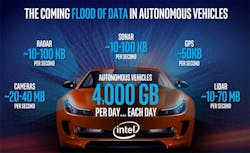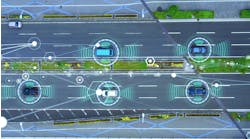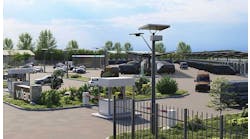When it comes to the data-driven future, there is no single technology that can transform American Internet infrastructure like the driverless car.
Autonomous vehicles are the equivalent of supercomputers rolling down the highway, generating and transmitting a mind-boggling volume of data – up to 4 terabytes per day, per car. As driverless vehicles take to the roads, they will require low-latency wireless connections to fiber networks and data centers. This connectivity, storage and data-crunching infrastructure will need to exist almost everywhere cars can drive.
“Anyone who wants to build an autonomous car must have a network of data centers,” said Brian Krzanich, the CEO of chipmaker Intel.
Widespread adoption of driverless cars remains years away, by most estimates. But the infrastructure spending has already begun. Ford is investing $200 million in a new data center to support its driverless car program. Toyota is working with NTT (the parent of RagingWire Data Centers) to create a global infrastructure for its autonomous vehicles.
Meanwhile, telecom carriers are expected to invest up to $5 billion in next-generation 5G technology – a high-speed wireless that will be a key enabler of autonomous driving – even before the 5G standard is approved in 2020.
That’s why self-driving cars are shaping up as a huge business driver for the data center business, particularly for service providers managing interconnection hubs.
“For us, this is the perfect storm,” said Jim Poole, Vice President of Ecosystem Development for Equinix, which operates a network of colocation facilities at key network intersections. “This data is moving from place to place, and there is a LOT of it. There are major challenges related to volume and latency. That translates into location, and we have gone out of our way to create a network that is close to users.”[clickToTweet tweet=”Jim Poole of Equinix on autonomous cars: For us, this is the perfect storm.” quote=”Jim Poole of Equinix on autonomous cars: For us, this is the perfect storm.”]
Transforming Cars, Cities and Energy
When Google went public with its development of driverless cars in 2009, it sounded like the stuff of science fiction. Eight years later, Google is just one of many players racing to make them real. This includes Silicon Valley heavyweights like Tesla, Uber, Apple, Intel and NVIDIA, as well as the major players in the auto industry and a fast-growing flock of startups .
The autonomous vehicle is seen as the leading edge in a digital transformation with the potential to remake the urban landscape and the energy market , as well as the automotive sector. Silicon Valley and Detroit are battling for supremacy, waging a war to win the hearts, minds and data of consumers. Autonomous vehicles are likely to be electric, a change which could transform infrastructure (think charging stations instead of gas stations) as well as emissions. Fully autonomous vehicles would create a huge market for in-vehicle entertainment, advertising and commerce.
Perhaps most importantly, AI-powered vehicles offer the promise of reversing a recent rise in traffic fatalities. More than 40,000 Americans died in motor vehicle accidents in 2016, up 14 percent from 2014. Safety experts say at least some of this increase is tied to distracted driving and the use of mobile phones.
The introduction of autonomous cars will take place gradually, as regulators seek to develop policy to guide their operations. There will be a lengthy transition period during which self-driving cars share the roads with traditional human-guided cars. No one yet knows precisely what this will look like, or the timing. But as the nascent industry surges ahead, the questions seems no longer to be “if” but “when.”
Data is the New Currency
One of the largest changes on the horizon is that autonomous vehicles will be driven by data, which ties together the systems that enable computer vision as well as the artificial intelligence that makes decisions about operating the vehicle.
That’s why one of the leading players in the connected car field is Intel, which is investing up to $250 million in autonomous driving technology. The chipmaker sees autonomous vehicles as the largest components in its vision for a data-driven world.
“Data is truly the new currency of the automotive world,” said Krzanich, Intel’s CEO. “In an autonomous car, we have to factor in cameras, radar, sonar, GPS and LIDAR – components as essential to this new way of driving as pistons, rings and engine blocks. Cameras will generate 20-60 MB/s, radar upwards of 10 kB/s, sonar 10-100 kB/s, GPS will run at 50 kB/s, and LIDAR will range between 10-70 MB/s. Run those numbers, and each autonomous vehicle will be generating approximately 4,000 GB – or 4 terabytes – of data a day.”[clickToTweet tweet=”Intel CEO Brian Krzanich: Data is truly the new currency of the automotive world.” quote=”Intel CEO Brian Krzanich: Data is truly the new currency of the automotive world.”]
There are currently 263 million registered passenger vehicles in the United States. The data storage and transmission math gets huge quickly. Adoption of self-driving cars by just 10 percent of American drivers, at 4 terabytes of daily data per vehicle, would generate 38.4 zettabytes of data annually. Data would need to move wirelessly, at scale, to connect a new digital infrastructure that will stretch nearly wherever cars can drive.
Several Tiers of Data Infrastructure
The data needs of autonomous vehicles will require a range of compute, storage and network infrastructure. These are likely to include:
- On-board computers, which will quickly resemble supercomputers
- Wireless connectivity to nearby towers and antennas
- Wireless connectivity to other cars and smart infrastructure (parking meters, traffic lights)
- Edge data centers (perhaps micro-data centers) to run analytics on data offloaded from vehicles and send on a smaller dataset for additional evaluation
- Core data centers to perform deep analytics on datasets forwarded from edge data centers
The leading players in high-performance computing (HPC) are already developing computers to enable on-board AI to power autonomous vehicles. NVIDIA recently introduced Xavier, a supercomputer designed for self-driving cars featuring integrating the company’s new Volta GPU architecture, a custom 8 core CPU architecture, and a new computer vision accelerator.
“This is the beginning of a new computer platform,” said Jen-Hsen Huang, CEO of NVIDIA, which is working on autonomous cars with Toyota, Tesla, Audi and Volvo.
An Intel FPGA hardware platform for connected cars on display at the AutoMobility LA show last November. The screen behind the hardware features a computer vision demo. (Photo: Rich Miller)
Intel, meanwhile, is positioning its FPGA (field programmable gate arrays) for use with its Xeon processors to power on-board AI for autonomous vehicles. The Intel GO in-vehicle development platform packaged Intel CPUs alongside Arria 10 FPGAs, which offers more than 320 Gbps of DDR4 bandwidth and more than 200 Gbps of transceiver bandwidth.
But on-board computing power is only the beginning of the infrastructure challenge around autonomous cars.
“The problems we see tend to be related to volume and latency,” said Poole of Equinix. “There’s on-board processing and actions that have to happen on the car. They will never send all the data back to their central office. The car doesn’t even try to do that until it’s back at its garage.”
Driverless Tractors as a Leading Indicator
Poole said autonomous vehicles will likely be supported by data centers at several levels, with data crunching done on the car, in a corporate data center, and in the cloud. That’s a configuration Equinix has seen with a customer that makes driverless tractors, which are already being adopted in precision farming.
“There’s no such thing as one data lake in the autonomous vehicle sector,” said Poole, who envisions data lakes – storage repositories that holds vast amounts of raw data until it is needed – at several facilities. “There is some near real-time information that is important to the vehicle, as well as data analysis that is being fed down to the vehicles. The data center plays a big role in that.”
“Autonomous vehicles are gathering a tremendous amount of data,” said Joe Kava, Vice President of Data Centers at Google, which is building driverless cars through its Waymo business. “That data is stored locally, but it has to be uploaded so you can have your ingest and run your AI and analytics. Are you going to have data centers in every city these cars are operating in? There are a lot of cities out there.”
A Waymo concept autonomous vehicle on display at the Computer History Museum in Mountain View, Calif. This model has no steering wheel. (Photo; Rich Miller)
The first step, even before the data centers, is wireless connectivity.
“These use cases will require very low latency,” said Mobeen Khan, the IoT Strategy and Product Management Executive at AT&T, which now has more than 13 million wireless accounts connected to cars. “The amount of data that our networks are handling each month continues to accelerate at an amazing rate.”
5G Will Lay the Groundwork
Autonomous vehicles won’t be widely adopted without low-latency wireless connectivity. This is one of the major business arguments for 5G, the next-generation of wireless broadband.
The 5G standard is still under development, with deployments unlikely to begin until early 2018 or 2019. But the goal will be a new level of connectivity that can support the data demands of autonomous vehicles.
“The importance of 5G to our self-driving future cannot be overstated,” said Intel’s Doug Davis. “Automated vehicles will both generate and take in huge amounts of data in order to navigate and react to sudden changes. Today’s communications systems simply were not designed to handle the massive bandwidth required to support this. That’s where 5G comes in, delivering faster speeds, ultra-low latency and vehicle-to-vehicle (V2V) connectivity for the era of automated driving.”[clickToTweet tweet=”Cowen & Co. Analyst Colby Synesael on 5G: This is going to be an instantaneous network.” quote=”Cowen & Co. Analyst Colby Synesael on 5G: This is going to be an instantaneous network.”]
Plans for 5G promise sub 10-millisecond latency for mission-critical apps, compared to the 50 to 100 millisecond latency for existing LTE broadband.
“That’s the difference between a car stopping on a dime or stopping in 20 feet,” said Colby Synesael, Managing Director and Senior Research Analyst at Cowen & Co., who tracks the progress of 5G. “This is going to be an instantaneous network.”
“A car going 60 MPH travels a third of a football field every second,” noted Cole Crawford, CEO of Vapor IO. “In this environment, human lives and property come down to decisions and information that can be made in microseconds, and the only way to do that is in an edge environment that is highly reliable and responsive.
“If there is some environmental change, a hardware failure or even simple network congestion, there won’t be enough time for a human to detect a situation and intervene,” Crawford added. “Applications must have autonomy. They must be environmentally aware, capable of ingesting situational data in real time, making lightning-quick assessments, then acting on those decisions without any human intervention.”
The Data Center Layer
A key strategy in addressing latency (often referred to as “lag”) is the edge of the network closer to data sources. This trend, known as edge computing, has huge implications for Internet infrastructure.
“We’re getting to see certain architectural implications for the network and distributing edge data centers,” said Gavin Whitechurch, founder of Internet of Things World. “The biggest driver is latency and making sure the network is used efficiently and gives immediate feedback.”
Vapor IO has launched Vapor Edge for Telecom, a platform to enable rapid deployment of edge capacity by wireless network operators and real estate investment trusts (REIT) specializing in the telecom tower business. a software suite to provide “lights out” management of data and facilities, along with tight integration with cloud platforms.
Other examples of edge data center concepts include the DataStation from BASELAYER and SRP, the DartPoints micro-data center, and modular enclosures from Vertiv. While some data center companies are positioning themselves for remote computing, others are beefing up their presence in second-tier cities, which have been the focus of increased investment focus and M&A action.
Each of these scenarios stands to see increased data flowing through facilities as more autonomous cars take to the road. Some of this data deluge will flow through to larger data centers that will store the data and run analytics.
An autonomous Ford Fusion, with sensors and cameras mounted. The head of Ford Smart Mobility, Jim Hackett, has just been named CEO. (Photo: Ford)
That’s why Ford is investing $200 million in a new data center in Flat Rock, Michigan to support its push into autonomous driving – a move that seems even more inevitable in the wake of Monday’s announcement that Jim Hackett, who had been running Ford’s Smart Mobility connected car division, will now take over as CEO. Ford expects its data storage requirements to increase from 13 petabytes today to more than 200 petabytes in 2021.
Ford isn’t alone in preparing for the data deluge to come. NTT is working with Toyota to research the likely impact of autonomous vehicles, and develop a network and data center topology to support it. Since the United States is the second-largest auto market (after China), an NTT collaboration with Toyota could mean substantial business for RagingWire Data Centers, which is now wholly owned by NTT.
Interconnection as Table Stakes
Just about all this data movement holds potential benefits for interconnection specialists like Equinix, which says it has already been seeing a business boost from early-stage elements of the connected car revolution.
“Most of the driving data and maps have been floating through Equinix since there were smartphones,” noted Poole.
Equinix has one of the world’s largest data center networks, but has focused its infrastructure in network hubs, with fewer facilities in regional markets that may see growth from driverless cars. These are early days, Poole notes, adding that Equinix is studying the potential evolution of auto use cases.
“We have 50 global metros that would satisfy the vast majority of use cases, even for the IoT,” said Poole. “We’re also looking, from an internal perspective, at what this might mean at the Tier 2 level and more remote locations. It could influence where we might go in the future. We are looking at it.”
However the autonomous economy evolves, Equinix figures to stand at the center of the network, moving traffic between its customers.
“Data has gravity, and you need an ecosystem to provide the interconnections,” said Poole. “These are the table stakes for this business. We are seeing this play out across the whole IoT.
“The reality is that the plumbing requirement never goes away,” he added. “You cannot fight physics. All the relevant players have to be connected together, and that has to happen all over the world. It has a huge impact. We’re in the middle. We’re the place that all that data goes.”






